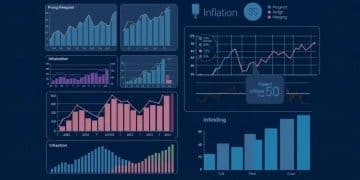Inflation-protected bonds become popular again

Inflation-protected bonds are designed to guard against inflation by adjusting their principal value, ensuring that your investment maintains its purchasing power while providing stable interest income.
Inflation-protected bonds become popular again as many investors look for security amid economic fluctuations. Have you considered how these financial products could fit into your investment strategy?
Understanding inflation-protected bonds
Understanding inflation-protected bonds is essential for investors looking to safeguard their assets during times of economic uncertainty. These bonds offer unique benefits that cater to the needs of those worried about inflation impacting their returns.
What are inflation-protected bonds?
Inflation-protected bonds, primarily known through the Treasury Inflation-Protected Securities (TIPS), are designed to protect investors from inflation. The principal amount of these bonds increases with inflation and decreases with deflation, ensuring that your investment retains its purchasing power over time.
Key features of inflation-protected bonds
- Principal adjustments: The bond’s principal is adjusted based on the Consumer Price Index (CPI), ensuring growth during inflationary periods.
- Interest payments: Investors receive interest payments based on the adjusted principal, providing returns that also keep pace with inflation.
- Tax considerations: While the interest is subject to federal tax, it may be exempt from state and local taxes, making it a favorable option for many.
Investing in inflation-protected bonds can be a smart decision for those who want to maintain their purchasing power. These bonds appeal especially during periods of rising inflation, as they provide a safety net against eroding asset values. It’s important to consider your overall investment strategy and risk tolerance when adding these bonds to your portfolio.
Additionally, understanding how and when to incorporate these bonds can create a more resilient financial plan. Investors should evaluate their current holdings and assess whether inflation-protected bonds might enhance their position amid changing economic landscapes. Remember that diversification is key; combining these bonds with other types of investments can lead to a more balanced and secure financial future.
The appeal of these bonds in today’s market

The appeal of these bonds in today’s market is growing as investors seek ways to protect their finances. With inflation concerns rising, many are turning to inflation-protected bonds to ensure their investment remains valuable.
Why choose inflation-protected bonds?
Investors are drawn to these bonds for several reasons. First, they provide a buffer against inflation, which can erode the value of traditional investments. As prices rise, so does the principal amount of these bonds, keeping pace with inflation.
Benefits of investing now
- Stable income: The interest payments adjust with inflation, providing a steady income stream that reflects the current economic climate.
- Reduced risk: By investing in these bonds, you can lower your overall investment risk during uncertain times.
- Diversification: Adding inflation-protected bonds to your portfolio can enhance diversification, making it more resilient against market fluctuations.
Furthermore, many investors appreciate the tax benefits associated with these bonds. They are exempt from state and local taxes, making them an attractive option for individuals in higher tax brackets. Understanding the full range of benefits these bonds offer allows you to make informed investment decisions.
This unique combination of features positions inflation-protected bonds as a compelling choice in today’s financial landscape. As the economy evolves, investors must adapt, and these bonds are emerging as a solid strategy for stability and growth.
How inflation-protected bonds work
Understanding how inflation-protected bonds work is key for investors interested in minimizing their risks during inflationary periods. These bonds are designed to adjust their value based on inflation rates, providing an effective safety net against rising prices.
Mechanism of inflation protection
When you invest in these bonds, your principal investment is linked to the Consumer Price Index (CPI). As inflation rises, the principal amount of the bond increases accordingly. This means your investment grows in value just when you need it most.
Interest payments
Investing in inflation-protected bonds also means receiving interest payments that adjust with inflation. This feature ensures that your returns keep pace with rising costs. Here are some key points:
- Fixed rate: The bonds typically have a fixed interest rate that applies to the adjusted principal amount.
- Quarterly payments: Interest is paid every six months, based on the current principal.
- Inflation calculation: The calculation for the bond’s value adjustment is done using the CPI, making it directly responsive to inflation.
Moreover, when deflation occurs, the principal amount of the bond will not fall below its original value at the time of purchase. This ensures a level of safety, allowing investors to retain their investments even during downturns. The unique structure of inflation-protected bonds provides both income and peace of mind, making them an attractive option in uncertain economic times.
For those considering adding these bonds to their investment portfolio, it’s crucial to understand how they function and how they can enhance overall financial stability. The simple yet effective design of inflation-protected bonds allows investors to focus on long-term growth while being shielded from the immediate effects of inflation.
Investment strategies for inflation-protected bonds

Investment strategies for inflation-protected bonds can enhance your financial stability, especially in times of rising inflation. By understanding how to effectively incorporate these bonds into your portfolio, you can safeguard your capital and potentially increase returns.
Diversification in your portfolio
Including inflation-protected bonds as part of your investment mix is a smart strategy. These bonds can act as a hedge against inflation, offering a buffer when other assets might decline in value. Here are a few benefits of diversification:
- Risk management: Balancing your investments across various asset classes can lower overall risk.
- Stable returns: Inflation-protected bonds can provide stable interest income, particularly when economic conditions are volatile.
- Long-term growth: They help preserve purchasing power over time, aligning with long-term investment goals.
Another effective strategy is to stagger your investments in inflation-protected bonds. This means purchasing bonds with different maturities to manage interest rate risk better. For example, investing in both short-term and long-term bonds can create a balanced approach that takes advantage of varying interest rate scenarios.
Evaluate your investment horizon
Understanding where you stand in your investment journey is vital. If you aim for a long-term investment, consider increasing your allocation to these bonds to ensure that you can ride out economic fluctuations. Additionally, consider how interest rate changes may impact the performance of inflation-protected bonds. Be aware that while inflation can increase the principal amount, rising interest rates may lead to fluctuations in the bond market.
Incorporate inflation-protected bonds into tax-advantaged accounts like IRAs or 401(k)s. This can enhance your overall returns by minimizing tax liabilities associated with interest payments. Structuring your investments with a focus on tax efficiency allows for greater growth over time.
Overall, approaching investment strategies for inflation-protected bonds with a clear understanding of your goals will lead to better financial planning and decision-making. This knowledge empowers investors to make confident choices in an ever-changing economic landscape.
FAQ – Frequently Asked Questions about Inflation-Protected Bonds
What are inflation-protected bonds?
Inflation-protected bonds are government securities designed to protect investors from inflation by adjusting the principal amount based on changes in the Consumer Price Index (CPI).
How do inflation-protected bonds provide income?
These bonds pay interest based on the adjusted principal, meaning that as inflation rises, both the principal and interest payments increase, providing a stable income stream.
What are the advantages of investing in inflation-protected bonds?
They help preserve purchasing power, offer stable returns during economic volatility, and provide tax benefits since their interest may be exempt from state and local taxes.
How should I include inflation-protected bonds in my investment strategy?
Incorporate them as part of a diversified portfolio to mitigate risk, consider staggering maturities for interest rate management, and evaluate their allocation based on your investment timeline.





